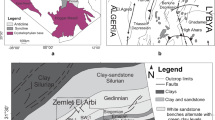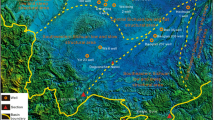Abstract
Using thin sections, scanning electron microscopy, electron probe, X-ray diffraction, and isotopic techniques, the formation mechanisms of authigenic chlorite rims in sandstones of the Middle Jurassic Sha 1 Member in the northeastern central Sichuan Basin are analyzed. Authigenic chlorite has three forms in Sha 1 Member sandstones, grain-coating, pore-lining, and pore-filling; pore-lining chlorite with a double-layer structure is the main type. The grain-coating and inner pore-lining chlorites formed in stage A of eodiagenesis, originating from the hydration and hydrolysis of silicate minerals and the transformation of montmorillonite to chlorite in Fe2+- and Mg2+-rich pore fluids. The outer pore-lining chlorite was deposited from stage B of eodiagenesis to stage A1 of mesodiagenesis and was related mainly to the transformation of montmorillonite to illite and the dissolution of silicate minerals with organic and carbonic acids releasing sufficient Fe2+ and Mg2+. The pore-filling chlorite, which was related to the dissolution of silicate minerals by carbonic acid from decarboxylation of organic acid and transformation of clay minerals (such as illite) to chlorite, formed mainly in phase A2 of mesodiagenesis. Fe and Mg for the authigenic chlorites mainly originated from dissolution of magmatic lithic debris and biotite rich in these elements and compaction fluids from the surrounding mudstones. The authigenic chlorites are mainly distributed in medium- and fine-grained sandstones of shallow lake beach bar, estuary bar, and subaqueous distributary channel microfacies.











Similar content being viewed by others
References
AliKhoudja SA, Chellat S, Hacini M, Semiani A (2020) Petrography and authigenic chlorite in the Siegenian reservoir rocks Berkine Basin eastern Algerian Sahara. Arab J Geosci 13:767–782
Alotaibi MB, Nasralla RA, Nasr-El-Din HA (2011) Wettability studies using low-salinity water in sandstone reservoirs. SPE. Res Eval Eng 14:713–725
Anjos SMC, De Ros LF, Silva CMA (2009) Chlorite authigenesis and porosity preservation in the upper Cretaceous marine sandstones of the Santos basin, offshore eastern Brazil. Clay Miner Sand 34:289–316
Bahlis AB, De Ros LF (2013) Origin and impact of authigenic chlorite in the Upper Cretaceous sandstone reservoirs of the Santos Basin, eastern Brazil. Pet Geosci 19:185–199
Branimir S, Giovanni Z, Andrea M (2020) On the origins of eogenetic chlorite in verdine facies sedimentary rocks from the Gabon Basin in West Africa. Mar Pet Geol 112:1–15
Cao Z, Liu GD, Meng W, Wang P, Yang CY (2018) Origin of different chlorite occurrences and their effects on tight clastic reservoir porosity. J Pet Sci Eng 160:384–392
Chen SJ, Wan MX, Du M, Zhang J, Xie BH (2005) Jurassic oil–gas source correlation and hydrocarbon source condition in central Sichuan region. Nat Gas Explor Dev 28:11–14 (in Chinese)
Chen XT, Xie QX, Qi W (2018) Study on the geochemical characteristics and tectonic environment of the Micangshan tectonic magmatic zone in the area of the Guangyuan city of Ying Chi. Sichuan Nonferrous Met 2018:11–13 (in Chinese)
Dowey PJ, Hodgson DM, Worden RH (2012) Pre-requisites, processes, and prediction of chlorite grain coatings in petroleum reservoirs: a review of subsurface examples. Mar Pet Geol 32:63–75
Ehrenberg SN (1993) Preservation of anomalously high porosity in deeply buried sandstones by grain-coating chlorite: examples from the Norwegian continental shelf. AAPG Bull 77:1260–1286
Gould K, Pe-piper G, Piper DJW (2010) Relationship of diagenetic chlorite rims to depositional facies in Lower Cretaceous reservoir sandstones of the Scotian basin. Sedimentology 57:587–610
Grigsby JD (2001) Origin and growth mechanism of authigenic chlorite in sandstones of the lower Vicksburg Formation, South Texas. J Sediment Res 71:654–656
Haile BG, Hellevang H, Aagaard P, Aagaard P, Jens J (2015) Experimental nucleation and growth of smectite and chlorite coatings on clean feldspar and quartz grain surfaces. Mar Pet Geol 68:664–674
Heald MT (1950) Authigenesis in West Virginia Sandstones. J Geol 58:624–633
Heald MT, AndereggR C (1960) Differential cementation in the Tuscarora sandstone. J Sediment Res 30:568–577
Huang SJ, Xie LW, Zhang M, Wu WH, Shen LC, Liu J (2004) Formation mechanism of authigenic chlorite and relation to preservation of porosity in nonmarine Triassic reservoir sandstones, Ordos basin and Sichuan basin, China. J Chengdu Univ Tech (Sci & Techy Edi) 31:273–281(in Chinese)
Huggett JM, Burley SD, Longstaffe FJ, Saha S, Oates MJ (2015) The nature and origin of authigenic chlorite and related cements in Oligo-Miocene reservoir sandstones, Tapti gas fields, Surat depression, offshore western India. J Pet Geol 38:383–409
Iijima A (2001) Zeolites in petroleum and natural gas reservoirs. Rev Mineral Geochem 45:347–402
Jahren JS (1991) Evidence of Ostwald ripening related recrystallization of diagenetic chlorites from reservoir rocks offshore Norway. Clay Miner 26:169–178
Kaiser WR (1984) Predicting reservoir quality and diagenetic history in the Frio formation (Oligocene) of Texas. AAPG Mem 37:195–216
Keith ML, Weber JN (1964) Carbon and oxygen isotopic composition of selected limestones and fossils. Geochim Cosmochim Acta 28:1787–1816
Lan YF (2011) Influences of authigenic chlorites on sandstone reservoir quality in Chang-8 member of the Upper Triassic Yanchang formation in Jiyuan-Huaqing area, Ordos basin. Dissertation, Chengdu University of Technology (in Chinese)
Li W, Qin SF (2012) Characteristics of trace elements and hydrogen and oxygen isotopes in the formation water of the Xujiahe formation, Sichuan basin. Acta Pet Sin 33:55–63 (in Chinese)
Li ZS, Li XC, Ma CH, Li JY, Zhang ZH, Gao X, Zhang WL, Xu CL (2008) Analysis method for carbon and oxygen isotope in organic matter and carbonate. National Energy Administration, Beijing (in Chinese)
Lin YT, Pan ZR (2001) Study on density and torming dassification of gas field brine. J Salt Lake Res 9:1–7
Line LH, Jahren J, Hellevang H (2018) Mechanical compaction in chlorite-coated sandstone reservoirs- examples from Middle-Late Triassic channels in the southwestern Barents sea. Mar Pet Geol 96:48–370
Liu JK, Peng J, Liu JJ, Wang Y, Liu JF (2009) Pore-preserving mechanism of chlorite rims in tight sandstone-an example from the T3x formation of Baojie area in the transitional zone from the central to southern Sichuan basin. Oil Gas Geol 3:53–58
Mahmoud E, Mohamed AN (2018) Effect of chlorite clay-mineral dissolution on the improved oil recovery from sandstone rocks during diethylenetriaminepentaacetic acid chelating-agent flooding. SPE J 23:1880–1898
Morad S, Aldahan A (1987) Diagenetic chloritization of feldspars in sandstones. Sediment Geol 51:155–164
Parker A, Sellwood BW (1983) Sediment diagenesis. Bjørlykke K. Diagenetic reactions in sandstones, Springer, Dordrecht
Pittman ED, Lumsden DN (1968) Relationship between chlorite coatings on quartz grains and porosity, Spiro Sand, Oklahoma. J Sediment Res 38:668–670
Pittman ED, Larese RE, Heald MT (1992) Clay coats: occurrence and relevance to preservation of porosity in sandstones. SEPM Spec Publ 47:241–255
Ren YG, Wang C, Wu HB, Yu J, Shao HM, Wang ZM, Wang GS, Guo HL (2011) Evaluating methods of oil and gas reservoirs. National Energy Administration, Beijing (in Chinese)
Sun ZX, Sun ZL, Yao J, Wu ML, Liu JR, Dou Z, Pei CR (2014) Porosity preservation due to authigenic chlorite coatings in deeply buried upper Triassic Xujiahe formation sandstones, Sichuan basin, Western China (Article). J Pet Geol 37:251–267
Tao SZ, Yang YM, Pang ZL, Yang G, Yang JJ, Yang XP, Wu YY, Zhang TS (2015) The fluid inclusion characteristics and formation, evolution of tight oil of Jurassic, Sichuan basin. Acta Petrol Sin 31:1089–1100 (in Chinese)
Tian JF, Chen ZL, Fan YF, Li PP, Song LJ (2008) The occurrence, growth mechanism and distribution of authigenic chlorite in sandstone. Bull. Mineralo Petrol Geoche 27:00–207 (in Chinese)
Virolle M, Brigaud B, Luby S, Portier E, Fenies H, Bourillot R, Patrier P, Beaufort D (2019) Influence of sedimentation and detrital clay grain coats on chloritized sandstone reservoir qualities: insights from comparisons between ancient tidal heterolithic sandstones and a modern estuarine system. Mar Pet Geol 107:163–184
Wang QW, Liang B, Kan ZZ (2007) Geochemistry and implications for the source areas and weathering in the Shaximiao formation, Zigong, Sichuan. Sediment Geol Tethyan Geol 27:17–21
Warren J (2000) Dolomite: occurrence, evolution and economically important associations. Earth-Sci Rev 52:1–81
Worden RH, Griffiths J, Wooldridge LJ, Utley JEP (2020) Lawan AY. Muhammed DD, Simon N, Armitage PJ
Xi KL (2016) Genetic mechanism of tight sandstone oil and gas reservoir of the Cretaceous Quantou formation fourth member in the southern Songliao basin, China. Dissertation, China University of Petroleum (East China) (in Chinese)
Xia H, Perez EH, Dunn TL (2020) The impact of grain-coating chlorite on the effective porosity of sandstones (Article). Mar Pet Geol 115:1–12
Xiang F, Wang YW, Feng Q, Zhang DY, Zhao JX (2016) Further research on chlorite rims in sandstones: evidence from the Triassic Yanchang formation in the Ordos basin, China. Arab J Geosci 9:507–508
Xie WR, Yang W, Zhao XY, Wei GQ, Xie ZY, Jin H, Chen G (2010) Influences of chlorite on reservoir physical properties of the Xujiahe formation in the central part of Sichuan basin. Pet Explor Dev 37:74–679
Yang YM, Yang JJ, Yang G, Tao SZ, Ni C, Zhang B, He XD, Lin JP, Huang D, Liu M, Zou J (2016) New research progress of Jurassic tight oil in central Sichuan basin. Pet Explor Dev 43:873–882
Yin G, Ni SJ (2009) Isotope geochemistry. Geological Publishing House, Beijing, p 87
Yuan GH, Cao YC, Wang YZ (2016) Dissolution mechanism and its impact on physical properties of feldspar and carbonate minerals in clastic reservoirs. Petroleum Industry Press, Beijing, pp 235–239(in Chinese).
Zhang W (2013) The evolution of the ancient lake and tight oil reservoirs formation of the early and middle Jurassic in the NE part of central Sichuan basin. Dissertation, Chengdu University of Technology (in Chinese)
Zhao YG, Wang M, Jiang YQ, Dong ZX, Wang SR (2010) Diagenesis of the low-permeability sandstone reservoir of the first member of Shaximiao formation in Gongshanmiao area and its influence on the reservoir property. J Xi’An Pet Univ (Nat Sci Edi) 25:7–22 (in Chinese)
Zhou QS, Lv CF, Li C, Chen GJ, Ma XF, Li CZ (2020) Formation mechanism of authigenic chlorite in tight sandstone and its influence on tight oil adsorption, Triassic Ordos basin, China. Energy Explor Exploit 38:2667–2694
Zhu JX, Li SZ, Zhu JW (1995) Study on diagenetic system of super-deep wells. Tongji University Press, Shanghai, pp 64–78
Acknowledgements
We thank the anonymous reviewers for their valuable suggestions and assistance in improving the quality of the manuscript and the Institute of Exploration and Development of PetroChina Southwest Oil & Gas field Company for sample collection and technical support.
Author information
Authors and Affiliations
Contributions
Conceptualization: Qinming Cao and Zhengxiang Lv. Methodology: Zhengxiang Lv. Formal analysis and investigation: Xiang Li and Yuanhua Qing. Writing—original draft preparation: Zhengxiang Lv. Writing—review and editing: Qinming Cao. Resources: Dong Huang. All authors have read and agreed to the published version of the manuscript.
Corresponding author
Ethics declarations
Conflict of interest
The authors declare they have no conflicts of interest.
Additional information
Responsible Editor: Domenico M. Doronzo
Rights and permissions
About this article
Cite this article
Cao, Q., Lv, Z., Li, X. et al. Formation mechanism of authigenic chlorite in sandstones of the Middle Jurassic Sha 1 Member in the northeastern central Sichuan Basin, China. Arab J Geosci 14, 1663 (2021). https://doi.org/10.1007/s12517-021-07721-z
Received:
Accepted:
Published:
DOI: https://doi.org/10.1007/s12517-021-07721-z




